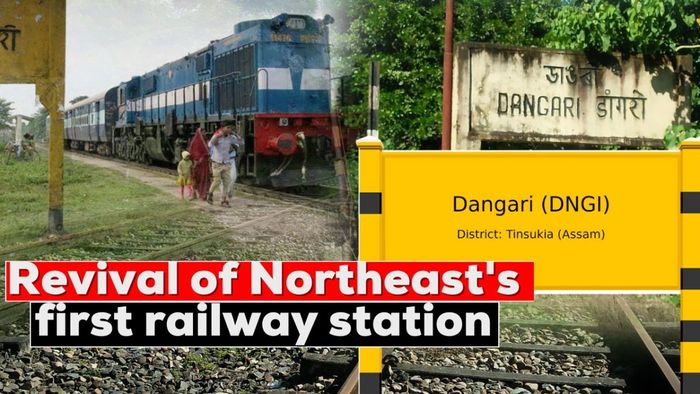Northeast's first, 137-year-old Dangari Railway Station in Assam awaits government attention
Assam's Dangari Railway Station established in 1883, was the first railway station in Assam and the entire Northeast, serving as a critical hub for the burgeoning tea industry initiated by the British in the undivided Dibrugarh district. This historic station now waits for government attention to restore its former glory.

- Jun 25, 2024,
- Updated Jun 25, 2024, 6:05 PM IST
Assam's Dangari Railway Station established in 1883, was the first railway station in Assam and the entire Northeast, serving as a critical hub for the burgeoning tea industry initiated by the British in the undivided Dibrugarh district. This historic station now waits for government attention to restore its former glory.
Dangari's story began with the British need for a robust transportation network to export tea from Assam's lush plantations to global markets. Located in the Sadiya region, 60 kilometers from Tinsukia, Dangari emerged as a vital node in this network. Along with other stations like Sadiya, Saikhowa, Talap, and Doom Dooma, Dangari facilitated the seamless transportation of tea.
Iconic steam engines such as Jayamati, Gadapani, and Lachit Borphukan became symbols of this era, hauling goods and ferrying hundreds of passengers daily from Dibrugarh to Sadiya. Despite the rail lines being meter gauge, passenger traffic remained high, with limited passenger trains amidst predominantly freight operations.
After India gained independence, the Sadiya region continued to be significant in the tea export industry. However, the devastating earthquake of 1950 dramatically altered Assam's geography, expanding the Brahmaputra River's range between Dhala and Sadiya. This catastrophe submerged the Sadiya and Saikhowa railway stations, but Dangari remained unscathed and operational.
The transition from meter gauge to broad gauge lines in the 1960s marked the beginning of a decline for Dangari. Railway authorities cited operational losses and ceased train services on this route. The beloved steam engines were relocated, with Jayamati now displayed at Heritage Park in New Tinsukia and another at the Dinjan Army camp.
In recent years, protests from various organizations, student bodies, and the public have called for the revival of services. The Northeast Frontier Railway (NFR) responded by running a demonstration train from Dangari to Makum junction. Despite these efforts, the current service struggles to meet passenger needs effectively.
Speaking to India TodayNE, District Vice President, AASU, Puheswar Sonowal said, "This train station was and continues to be the lifeline of the people of Dangari. The rich heritage and legacy that this station carries, cannot be compared with any other stations across the northeast because this was the first railway station built during the British era. Unfortunately, due to neglect by the administration and railways, the station now stands in shambles with several of its structures lying in poor condition. The ticket booking counter, the station master's quarter all remain in poor condition. The locals here and student organisations have regularly raised our concerns with the government and the railways, but no action was initiated. Not a single train passes through this line which was once abuzz with sounds of moving train, transporting coal and tea leaves to other parts of northeast. We have submitted a memorandum to the Northeast Frontier Railways in Guwahati to look into the matter at the earliest as the station calls for revival which will help a lot for the people of this region".
Protests led by the Tinsukia unit of the All Assam Students' Union, the Assam Rail Passengers' Association, and local residents have demanded the revival of the historic Dibru-Sadiya-Dangari railway line. They urge the railways, state, and central government to resume services, stressing the line's importance for better connectivity.
The closure of stations like Barhapjan, Hansora, Doomdooma, Rupai, Talap, and Dangari has left the Makum Railway Junction and five other stations non-functional. Although a Diesel-Electric Multiple Unit (DEMU) train operated briefly, it was discontinued. Currently, these stations remain locked and deteriorating.
The Dibru-Sadiya Railway, one of the pioneering railway companies in British India, marked the beginning of railway services in Northeast India. Owned by the Assam Railways and Trading Company (AR&TC), the metre-gauge railway transported coal, tea, and passengers, supporting the tea industry's rapid growth. The first section opened in 1882, and Assam's first railway junction, Makum Junction, followed in 1884. The network converted to broad gauge in the late 1990s.
Dangari Railway Station, the cradle of Assam’s rail history, remains a symbol of the region's heritage and the relentless spirit of its people. While operational challenges persist, the station's legacy continues to inspire, reminding us of its vital role in the tea trade and beyond.
Also read: Tripura CPIM alleges BJP threats in state, demands fair election measures for Panchayat polls